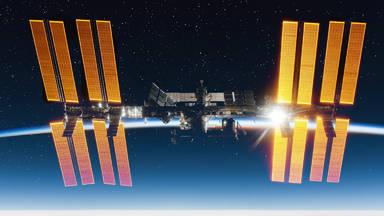
On September 14, 2011, NASA announced they are ready to start the development of a new deep-space exploration rocket called the Space Launch System (aka SLS). Yet here we are nearly 10 years later, and we have not even seen a single SLS launch. NASA is planning a debut launch in the second half of this year. But given that NASA expects each launch to cost over 2 billion dollars, would it be better if the Space Launch System was just defunded altogether?
To answer this, let us first take a look at why SLS is even being developed, starting with Orion. For several years NASA has been trying to get their Orion Spaceship into deep-space, and eventually the moon. However, they have struggled to find a rocket that is powerful enough to do so.
Orion is quite heavy coming in at 22.7 metric tons. to put that in perspective, the Falcon 9 rocket can only barely get Orion into low earth orbit. With SLS, on the other hand, NASA is aiming extremely high. They are planning on creating both a 70-metric-ton variant and a 130 metric ton variant. If NASA succeeds in achieving these ambitious payload capacities, SLS would claim the title of being the most powerful rocket in history by quite a margin. The most similar comparison today would, of course, be Starship which is expected to have a payload capacity of 100 metric tons. So Starship would be right in between the two SLS variants.
He argues that having to launch 2 heavy-lift rockets just to get to the moon is neither optimal nor sustainable. Aside from being the more efficient method, Bridenstine emphasizes that refilling crewed vehicles in orbit is complex and adds undesirable risk to the astronauts.
This is absolutely a valid point. But it should be noted that NASA has been already docking crewed vehicles with the international space station for decades. So it is not like docking in orbit has never been done before. Not to mention, NASA has never experienced a major problem while docking. Anyway, the first major advantage SLS offers is simply raw power. SLS boasts a massive payload capacity and it does not need to be refueled in space. Therefore, NASA is hoping to use SLS to get to the moon and eventually maybe even Mars.
The other major reason that SLS is still being funded is that NASA has no way of conducting crewed missions by themselves. The last flight of the space shuttle was way back in July of 2011, so NASA has not had crew launching capability for nearly 10 years so far.
Starting in 2020 they did gain the ability to launch crews from America with the help of SpaceX. But that is still not the same thing as launching by themselves, and having a government-owned crew launch system is a priority for congress. Since 2010 congress has been guiding NASA through exactly how powerful they want the rocket to be, exactly where the rocket will be used, and when the rocket is to be completed.
Of course, this is not surprising. China’s national space organization is rapidly progressing. In fact, they have launched the first parts of their own space station this year. Similarly, India is also making significant progress and it is only a matter of time until they gain the ability to launch humans into space. Considering this, the United States should be able to conduct their crewed missions too, even if it is not the most economical.
So literadthose are the two most significant arguments in favor of the Space Launch System. But let us also take a look at the various drawbacks of the program. Starting with the cost.
The amount of money that is going to cost to launch one of these rockets is absolutely ludicrous. In 2019, The White House sent a letter to the senate appropriations committee which revealed that NASA expects the first SLS launch to cost over 2 billion dollars, and that does not even include development costs for the past 10 years. NASA has received 2 billion every single year just to develop SLS. Also do not forget the cost of developing and operating the Orion Spaceship. As of July 2020, NASA had already spent 16.7 billion dollars on Orion and they expect to spend 12.8 billion more by 2030. Adding those figures together, we get a total of 29.5 billion dollars on just Orion.
Of course, it should be noted that politics have heavily inflated this amount. Throughout the life of Orion, the constellation program was created and then defunded, and a series of events has gone down as well. Hence, the exuberant cost is not necessarily NASA’s fault. Whoever’s fault it is though, at the end of the day, SLS, unfortunately, cost a ludicrous amount.
At this rate, it is very likely the first crewed lunar mission NASA completes with SLS and Orion will end up costing 3 billion dollars, if not more. Even the infamously expensive space shuttle did not cost that much. The total lifetime cost of the space shuttle program was 209 billion dollars, and this allowed for 134 flights. On average each flight was costing about 1.6 billion dollars. This means that the first SLS launch will cost nearly double the cost of a single space shuttle launch, and the space shuttle was already super economically unfriendly.
If we compare SLS to Starship, it honestly just gets depressing. SpaceX is targeting just 2 million per Starship launch which means that SpaceX could complete 1000 Starship launches for the same price NASA completes just one SLS launch. Even If that Elon Musk is being overly ambitious and each Starship launch ends up costing 50 times more at 100 million dollars, SpaceX could still complete 20 Starship launches for the price that NASA completes just one. Over the long term, NASA is targeting to bring down the per-launch cost closer to one billion dollars, but that is still quite bad.
Moving on, the other most significant drawback of SLS is its outdated design. For starters, SLS is straight-up using RS25 engines which are the same engines that were used on the space shuttle. But more importantly, it is using an outdated concept which is a non-reusable rocket design and this is quite disappointing. NASA was looking at creating reusable rockets way back in the 1970s with the space shuttle, but today they ended up settling on a non-reusable design.
It is possible to recover certain parts of the Space Launch System such as the SRBs, but NASA already tried this with the space shuttle, and this rarely saved any money. The refurbishment process was simply so complex and costly that it simply makes more sense to make a new set of SRBs for every launch. As for the main core stage of the rocket, or the big orange middle part, unfortunately, NASA designed the rocket in a way where the core stage goes too far up at two high velocities for a recovery to be practical. Adding parachutes to slow down the core stage would simply result in too big overhead to the payload. Considering these shortfalls, NASA decided to simply scrap reusability.
With all that being said, should SLS just be defunded?
Indeed SLS is super inefficient and expensive, but it still can complete this mission successfully. NASA has some of the smartest people in the world working with them, and though it is unfortunate that politics often stalls their progress and inflates their cost, NASA is very well capable of developing great rockets. If you just take a look at SLS itself, it is literally the most powerful rocket humans ever built. NASA engineers have already spent 10 years developing the Space Launch System and it looks like we are finally on the home stretch with the first test launch coming up. So perhaps it is only proper that NASA’s engineers get to see their project through.
Moreover, it is very possible that SLS is the final major project that NASA will complete by itself. As we discussed throughout this entire article, the private space industry is pushing the boundaries of space technology, and subsequently leaving NASA behind. Indeed people at NASA know their various limitations and this is precisely why they are spending so much money on commercial contracts. As the private space industry continues to evolve and the gap widens, it is very likely that NASA just becomes a funding agent for commercial contracts. Thus, SLS may very well be their last opportunity to put humans on the moon mostly by themselves.
Moreover, it is not like the massive cost of SLS is truly a problem. Indeed, it is extremely disappointing that it costs NASA so much, but at the same time, a two billion dollar launch cost is not a real obstacle for the government. If we compare it to the recent 1.9 trillion stimulus bill the government just passed, NASA could complete nearly a thousand SLS missions.
At the end of the day, it is no question that NASA is severely lagging behind the private space industry, but there would be no private space industry if it was not for NASA in the first place. NASA used to be the leader in space, but unfortunately, they had a bit of an accident with the space shuttle program. However, they are still trying their best with SLS, and they should have the opportunity to be pushed through the finish line one last time. The root of NASA was based on getting people to the moon, so it makes sense that their solar journey ends with them placing more people on the moon. After this though, unless NASA can meaningfully compete in terms of cost, they should just leave it to the private space industry.









